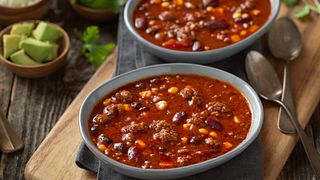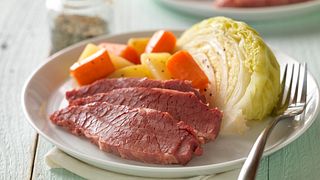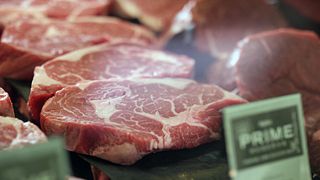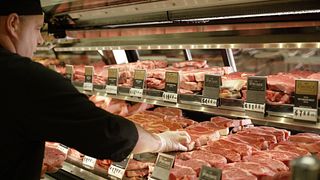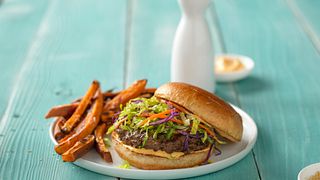lean beef choices for today's consumers
September 23, 2019
Beef choices abound for today’s shopper. From the indulgent and celebratory Ribeye Steak or Roast to a more affordable – and lean – Sirloin Steak. (Spoiler alert: Tenderloin Steak is also lean.) And, lean cut sales have increased 12% since 2014 (Figure 1). But what is lean? Who might be interested in these options? And, what opportunities do these choices provide for your retail meat case?
Source: IRI/Freshlook, Total US MULO ending 7/28/19; Categorized by VMMeat System
Overall, beef is a nutrient-packed protein which provides 10 essential nutrients and, on average, half the protein Daily Value in a single 3-ounce cooked serving. According to USDA, a lean beef serving of about 170 calories (3-oz, cooked, with visible fat trimmed) contains less than 10 grams of total fat, 4.5 grams or less of saturated fat, and less than 95 mg of cholesterol.1 In fact, shoppers seeking a great-tasting,2 lower-fat and reduced-cholesterol beef option have many choices in your meat case.
And, lean products sell – especially when consumers are educated on these options. For example, while 93% lean and higher Ground Beef sales have increased 13%, American Heart Association Heart Check-labeled 96% lean Ground Beef3 sales have grown a full 37% over the five years ending 2018.4
Thirty-six beef cuts meet lean guidelines and are included in USDA’s National Nutrient Database.5 By proximity, product form, carcass location and muscle type, however, more than 40 additional cuts are likely lean as well.6 For example, whereas a Tenderloin Steak is officially lean, a Tenderloin Filet is likely to be lean as the filet is the same muscle as the steak. (The Tenderloin Filet differs from the Tenderloin Steak in that the filet is skinned with the side muscle off.)7 And Choice as well as Select quality grades for these cuts qualify as lean.
Lean cut sales growth aligns with that of total retail beef sales, driven by increasing supplies and stronger demand.8 As middle meat cut sales have been particularly robust in recent years,9 it’s no surprise to see Loin cuts propelling lean sales higher, particularly amongst the top-selling items (Figure 2). While Tenderloin Steak appears to be an exception to this trend, thriving Tenderloin Filet sales (a near-direct substitute) are more than making up for flat Tenderloin Steak sales.
Source: IRI/Freshlook, Total US MULO ending 7/28/19; Categorized by VMMeat System
The fastest-growing lean cuts are noted in Figure 3. Included are cuts with sales increasing faster than average with at least $50 million in annual retail sales. Again, the Tenderloin Filet appears, with rapid growth off a strong base. The lesser-known Sirloin Bavette, however, is certainly gaining momentum while the Tri-Tip, Top Sirloin Filet and Strip Loin are finding more favor – and carts – as well.
Source: IRI/Freshlook, Total US MULO ending 7/28/19; Categorized by VMMeat System
By primal, many lean cuts come from the Loin and Round, which therefore dominate lean sales.10 Figure 4 shows 86% of lean cut dollar sales are from these two primals, while smaller shares are from minor primals (Brisket and Flank) as well as Shoulder and Chuck. The Loin’s strong dollar share is driven by higher-end steak, filet and roast items whereas the relative affordability of Round cuts contributes to their higher pound share.
Source: IRI/Freshlook, Total US MULO ending 7/28/19; Categorized by VMMeat System
Lean cut sales by product form are dominated by steaks, which account for 72% of dollar sales. Roasts and filets follow at 19% and 7% of dollars, respectively. Other popular items which are often from the Round and therefore lean include Cubes, Cubed Steak and Dices. Kabobs and Strips are more frequently identified as Sirloin, also qualifying these items as lean. These pre-cut options total 6% of beef cut sales and offer consumers lean alternatives with added convenience for their beef dishes.
Seasonally, Loin steaks drive lean cut sales in summer whereas roast and Round cut sales generally strengthen during colder months. Exceptions to this include the Top Round First (a.k.a. London Broil) and Eye of Round Steaks which see plentiful summer sales. Whereas middle meat steaks come grill-ready, these Round steak cuts benefit from a tenderizing marinade for a best beef eating experience.
Lean cuts offer today’s beef consumer many choices. For those looking to moderate fat, cholesterol or calories while enjoying the great taste of beef, savvy retailers can help shoppers identify the many meat case options to best meet their needs.
- USDA, Nutrient content claims for fat, fatty acids, and cholesterol content. 9 CFR § 317.362. 2018. (According to USDA, a cut of cooked fresh meat is considered “lean” when it contains less than 10 grams of total fat, 4.5 grams or less of saturated fat and less than 95 mg of cholesterol per 100 grams (3 ½ oz) and RACC (Reference Amount Customarily Consumed), which is 85 grams (3 oz).
- Consumer Beef Tracker, NCBA, 2019
- https://www.beefitswhatsfordinner.com/sales-data-channel-insights/retail-insights/ground-beef-sales
- IRI/Freshlook, Total US MULO ending 3/26/19; Categorized by VMMeat System
- https://www.beefitswhatsfordinner.com/nutrition/lean-beef
- Click
here for the complete list of lean and likely lean cuts
- Uniform Retail Meat Industry Standards (URMIS), 2014. For further information on retail standards, please visit MeatTrack.com.
- IRI/Freshlook, Total US MULO ending 7/28/19; Categorized by VMMeat System
